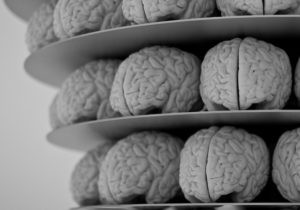
2.5 quintillion. What does that even mean? It sounds like the sort of number Carl Sagan might have once thrown around on his classic TV series Cosmos. It is, believe it or not, the number of bytes of new data created every single day.
Just to put things into perspective, as if you actually could conceptualize a number that huge with the 100 billion neurons in your puny little human brain (yeah, that includes you, Albert Einstein!), 2.5 quintillion pennies would, if laid out flat, cover the Earth five times. (They?d all be American pennies, since Canada had the cents to stop minting them in 2012. Ar ar!)
It?s also one-quarter of all individual insects alive at any time. (Now there?s a disturbing thought.)
 Every time the U.S. President tweets, this is what the ensuing Twitter trend looks like, conceptualized. With bugs. Photo by Steven Depolo on Flickr
Every time the U.S. President tweets, this is what the ensuing Twitter trend looks like, conceptualized. With bugs. Photo by Steven Depolo on Flickr
One quintillion is one thousand quadrillions, which is one thousand trillions and one trillion is the number it?ll take for Bill Gates to be the world?s first trillionaire, possibly in 25 years, which is a distinct possibility. So 2.5 quintillion would equal Bill Gates?s projected fortune times 2.5 million, assuming he lives to see 2042.
 Waiting to be queued up along the equator. Photo by Neil Conway on Flickr
Waiting to be queued up along the equator. Photo by Neil Conway on Flickr
Or, it?s 250 million human brains (counted in neurons). We?re not mathematically inclined enough to figure out how much of the earth those brains would cover without being mashed flat (ewww) but laid end to end, those brains would cover 25,942.25 miles. That would stretch across the entire length of the equator and a little beyond. (Disturbing mental images? You?re welcome!) Anyway, that would be 2.5 quintillion human brain neurons, neatly packaged in three-pound organs, as a bizarre conceptualization of the number 2.5 quintillion.
As we mentioned before we went off on this weird tangent about human brains, it?s also quotidian quintillions! (Don?t worry, we won?t go off on an irrelevant tangent about gratuitous alliteration!)
At least some of that daily data will need to be translated for foreign language speakers. Not everything of course as plenty of that data is graphics, non-lingual audio, or video without need of explanation, like two million cat videos (as of 2014), and that?s just one category of non-lingual video data.
But in 2013, 500 billion Microsoft Office documents were created. That?s just one document creation platform. As of March of last year, there were over 1.1 billion websites on the Internet, and it only took twenty-three years to get there from the creation of the first website in 1991 (it?s stayed fairly steady for a few years). You can view all of them here and watch as they increase.
A global look at that daily 2.5 quintillion
 Photo by Frankieleon on Flickr
Photo by Frankieleon on Flickr
Meanwhile, the world is becoming more and more connected. There are over three billion people on the Internet today, which is about the number of the total world population in 1960. Here?s the global breakdown of the population percentage with Internet access in each region as of June 2016:
- Asia 6%
- Europe 9%
- Latin America & Caribbean 5%
- Africa 7%
- North America 0%
- Middle East 4%
- Oceania/Australia 3%
The fastest growth rates from 2000?2016 were in Asia, Latin America, Africa and the Middle East.
Social media contributes to a huge chunk of that 2.5 quintillion figure. People are talking to each other across national and lingual borders as never before. We tweet, update our status, share information, comment on YouTube and discuss everything imaginable in forums. We blog, text each other, create memes and exchange photos and videos with a lot of LOLs and OMGs, although the acronyms vary across languages.
It helps that English has been a must-have language for most of the world but that?s quickly changing as English becomes overwhelmed by the sheer number of Chinese users alone. There?s also some social resistance from nationalist Netizens who are happy to see the Internet?s former lingua franca fall from grace. Global business may be standardizing on English but many online shoppers are saying Non/Nein/Nei/Oya/Maley/Heunteu/Maya/U?a to English.
As we?ve pointed out many times before, people prefer to shop in their own language. You might be able to muddle through an eCommerce site in a language you?re only somewhat familiar with but what about when you get to the checkout? What do the series of messages or drop-down menus say? Are you picking the right shipping method? Now you?re entering your credit card number. What will you do if something goes wrong because you ordered improperly? Who will you talk to? Will you be able to understand them?
How not to sell your products to the rest of the world
 Photo by Lwp Kommunikci on Flickr
Photo by Lwp Kommunikci on Flickr
The last thing you want to do while making a sale is introduce the element of fear.
Just ask any salesperson, anywhere, what happens when the customer feels any sort of trepidation about completing a sale.
Related: Translation Tools ? A Perfect Storm for Data and Localization
Analysts trying to figure out the reasons behind online shopping cart abandonment rates need to consider where those would-be customers reside. If they?re in countries where English isn?t the primary language and the website isn?t localized, one reason for the abandonment could be discomfort with suddenly realizing you?re ordering from some company who may or may not be extremely difficult to deal with if something goes wrong ? the likelihood of which increases the more the customer can?t speak the eCommerce site?s language competently.
As more and more people around the world gain Internet access, English will continue to lose its online cachet. We want to talk to each other, exchange Snapchats, order consumer goods, get proper customer service help, as well as read each other?s blogs, comments, white papers, data documents and tweets. I?m sure we agree that 2.5 quintillion bytes of data created every single day is a helluva lot of data and it will be increasingly important to translate it into other languages in a timely manner.
Consider this: At the current daily rate of data creation, one year?s worth measured in brains containing 100 billion neurons apiece would be 91,250,000,000 thinkers. Laid end to end, they?d get you to?er?ten million miles from earth, with no place to stop off anywhere to refuel or grab a burger.
But it?ll be nippy that far from the Sun, so pack your thermal underwear.
 A conceptualized view of the number of narcissistic super-attractive selfies uploaded to social media since you started looking at this picture. Photo by Sweetie187 on Flickr
A conceptualized view of the number of narcissistic super-attractive selfies uploaded to social media since you started looking at this picture. Photo by Sweetie187 on Flickr
This post originally appeared on the Yappn blog Yappn About.
Yappn Corp is an enhanced machine translation company with a lot of great multilingual brains working here, but we prefer to keep them in our heads instead of using them as rulers to demonstrate what a whole bunch of new data bytes looks like. For more information please contact our brainiacs at [email protected] or call us at +1.905.763.3510 x246.
Never miss out on another Yappn blog post! We love language, translation, and the cool machine translation technology driving it. Not to mention eCommerce, Asian growth, and how we?re all learning to communicate better with each other. Sign up for our new post email notifications today!
Written by Nicole Chardenet, Sales Development Rep at Yappn


